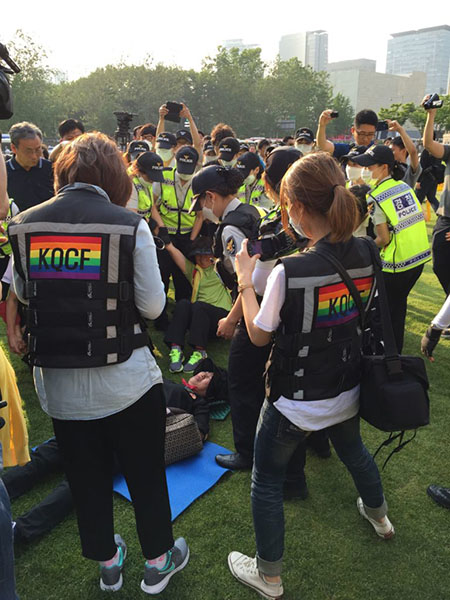Editor’s Note: This post is part of our ongoing series, “Queering Surveillance.”
Surveillance is an embodied experience, both being watched and watching. The sheer number of concert-goers recording Cher’s “Here We Go Again” concert this past year with their phones had them trade singing and dancing for an act of documentation. Whether the recordings are to remember the experience later, share the experience with others, or to simply document one’s presence in that space and at that time, recording the concert on one’s phone becomes an experience in its own right. They are present in the space, but their attention is about both what is happening in the here and now and the recording that filters the experience in the future. Their phones and recordings are central to their embodied experience, fused into one like a cyborg traveling across space and time in the moment. Add to this that countless concert-goers are recording the same concert from their individuated perspective, and thus the concert becomes infinite and virtual—of course, the way Cher was always meant it to be.
Back here on the ground, though, embodied experience of surveillance is part of daily life for most of us. There are moments of contact, of friction, and contraction, where we are confronted with the cyborg-like quality of watching and being watched. In our last blog post we explored the queer surveillance practices of young Korean activists and college students. Expanding upon the groundwork we laid there, in this post we ruminate on both the embodied experience of surveillance and overlapping and interactive manifestations of surveillance for queer activists in South Korea. We once again point out the ways queer activists blur the line between those documented and those documenting.
The Overlap

Picture of anti-LGBT protesters, police, and Queer Culture Festival Staff.
June 2015 was a momentous month for queer and trans communities in South Korea. For the first time, Seoul’s annual Queer Culture Festival was held in Seoul City Hall Plaza in downtown Seoul with tens of thousands participating in attendance. There were two dates of events: an Opening Ceremony in the evening on June 9th and the day-long festival and parade through Seoul on June 28th. Conservative Christian protesters camped out all around Seoul City Hall Plaza on the 9th hoping to stop the Opening Ceremony, and when festival organizers arrived to begin the work of setting up the space, riot police were not far behind. Protesters took to lying on the ground to prevent movement and construction. Police ended up picking them up and dragging them off.
A couple festival organizers in flak jackets took to documenting the scene, mirrored by police officers tasked with the same job. There were moments of confrontation, between police and protesters, that culminated in overlapping forms of surveillance. Pictured above, one such moment was captured by Gitzen. Present are not only the police, protesters, and festival organizers, but members of the press there to document the confrontation. Seven cameras are visible, two are not. Everyone was documenting the same scene, except for one of the hidden cameras. He was documenting the others documenting the scene. More on him later.
Our initial read of the picture and the experience mirrors our last piece: the intentions and perspectives of those doing the surveillance can vary. It is hard to tell all of those intentions, but some are discernible. Festival organizers—and queer activists in general—often spoke of their actions as reactions to anticipating complaints and claims of wrongdoing. They document to create evidence of their innocence. Police may also document to create evidence, but to what ends? The press are in the business of documenting. These are not equal forms of surveillance. Despite not being carted away, festival organizers recorded because they had to, because they might be blamed for any violence that erupts if evidence proving otherwise does not exist. Surveillance is thus a means of survival.
Surveillance overlaps, but again, it’s also embodied. Queer activists are always documenting, always watching, their events and moments of confrontation. It’s become an extension of their bodies, part of their experience. They are surveillance cyborgs. The camera or phone is always in hand or arm’s length away, and like the concert-goers, recording an event for posterity supplants an immediate experience in the present. In this way, surveillance confuses temporal boundaries between past, present, and future, regardless of the part being played. How is experience augmented not only through the lens of the camera, but through being caught between multiple timelines?
The Surveillance Ethnographer
Then there is the invisible ninth camera-wielding individual watching everyone. The ethnographer, Gitzen. What are his stakes in this moment of friction? Katherine Verdery has made abundantly clear in her new book My Life as a Spy that an ethnographer’s methods may overlap with the spy’s toolkit. And more relevant to this picture and moment, the ethnographer’s method could very well be construed as a method of surveillance.
Watching others watch and document each other, though, is a different form of surveillance and itself a slightly different mode of ethnography. If those in the picture straddle multiple timelines, then the ethnographer must exist in all those different timelines as well, though others may not be aware of their presence. Perhaps the ethnographer is the true surveillance cyborg, integrating the cameras of everyone else—the perspectives of those recording—in attempt to piece together an ever-more detailed picture.

5 Trackbacks